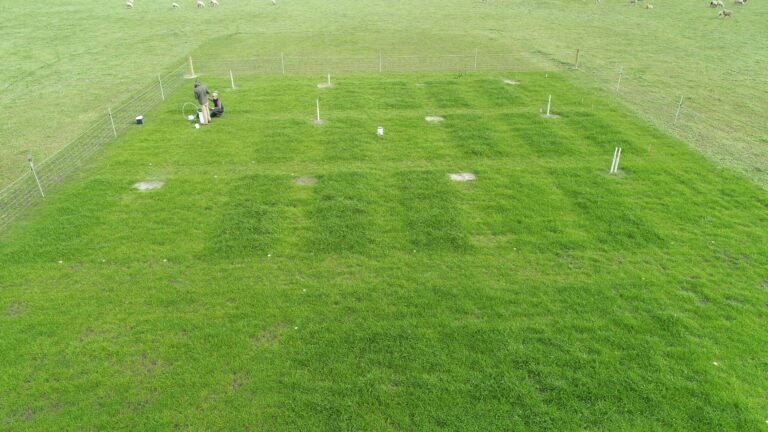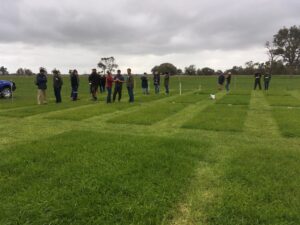
2020 nitrogen trial site.
Winter is here and pastures are transforming back into their lush, green carpets.
This is a great time to start planning for the winter feed-gap caused by the slower growth period during the wet, cold season in July-August.
A trial undertaken back in 2020 by agronomist Graham Mussel, showed that applying nitrogen AFTER rain in winter can result in an extra 24 kg of dry matter per kilogram of nitrogen over two months, compared to where nitrogen was not applied.
The details of this pasture response on a Busselton farm are explained by Graham below.
Nitrogen trial explained

“The trial looked at how nitrogen can be used strategically on grass-dominant pastures during the cold and wet period to fill the winter feed-gap in July-August when pasture growth is slow,” Graham said.
“During warmer months with adequate soil moisture, organic sources of nitrogen in the soil are mineralised by microbes, supplying significant quantities of nitrogen to plants. However, lower temperatures in winter reduce microbial activity and mineralisation, resulting in very slow growth, especially in grass-dominant pastures without much clover.
“The outcome is that farmers need to continue supplementary feeding at considerable cost while the risk of overgrazing is increased.”
The trial site was sown with Ascend ryegrass and had some clover germinate from the seed bank.
The Results
Results showed that an application of 50 kg of nitrogen (110 kg of urea) in late June resulted in an extra 24 kg of dry matter per kilogram of nitrogen over two months, compared to where nitrogen was not applied.
“This calculates out to $54 per tonne of dry matter. You can’t grow and conserve hay or silage for that much.
“However, we did see some exceptional production in the trial because we weren’t getting heavy rains and waterlogging.”
Weighing the risks
The downside of applying nitrogen in winter is the increased risk of leaching.
However, Graham demonstrated that this can be managed with better timing of applications.
“The risk of leaching is very relevant here because our sandy soils are prone to leaching, and because nitrogen is often applied before a cold front arrives so it can be washed in,” he said.
“The thinking behind applying before rain is the perception that nitrogen will volatilise if left on the surface.
“However, work by Richard Eckhart in the eastern states has shown that the risk of volatilisation in cooler, wetter months with low evaporation is very low, whereas the risk from leaching is much higher.
“If you only get 15 mm that’s fine, but if you get more than 50 mm you’ve wasted your money and potentially caused an impact downstream.”
Downstream impacts are particularly relevant around Busselton with a lot of the farmland draining into the Vasse-Wonnerup wetland, designated as a Wetland of International Importance under the Ramsar Convention, but also one of the most nutrient enriched aquatic ecosystems in Western Australia.
Testing the theory
To test the theory in the South West, urea was applied to some trial plots on 26 June 2020 before a 34 mm rainfall event (falling over four days), and then to other plots on 30 June 2020, with the next significant rain event occurring six days later.
“We got the same response in terms of dry matter production regardless of whether we applied nitrogen before or after rain, so why would you go before the rain when the risk of leaching is high,” Graham said.
Another key learning from the trial was not to apply nitrogen when soil moisture is low towards the end of the growing season.
“When we ran out of moisture in spring, we didn’t get the response from nitrogen that we hoped for,” he said.
“Conditions have got to be favourable for growth, so you need soil moisture and good spring rains.”
Good grazing management is also critical to get a return from an investment in nitrogen fertiliser.
“If you’re going to use nitrogen you’ve got to be in a position to rotationally graze,” he said.
“Everybody loves producing lots of green grass, but if you can’t utilise the extra production with a rotation before quality drops, you’re not getting the best return on money spent, so you have to consider whether it’s worth it.”
Autumn fertiliser
Graham later used a 2021 event in Capel to also demonstrate that autumn fertiliser (phosphorus and potassium) can be applied at least three weeks after germination without any impact on germination.
Clover and ryegrass were sown into six pots containing washed white sand with virtually no soil phosphorus (Cowell phosphorus <2mg/kg, PBI 8.4).
Luxury amounts of phosphorus, potassium, sulfur and trace elements were applied to three pots while nothing was applied to the remaining three pots where seedlings could only grow from nutrient reserves in the seed.
There appeared to be no difference in the pots 22 days after sowing, supporting best practice recommendations that autumn fertiliser can be top dressed after the season breaks (and seedling emergence) to reduce leaching losses.
Key findings
- Applying nitrogen in cold and wet conditions can increase the yield of grass-dominated pastures and can be more economical compared to supplementary feeding, assuming additional growth can be adequately utilised by animals.
- Nitrogen fertiliser can be applied after rain events in cool and moist conditions when the risk of leaching is high and the risk of volatilisation is low.
- Only apply nitrogen when soil moisture is adequate for plant growth (More here).
- If soil tests show autumn fertiliser is needed, it should be applied after pasture emergence to reduce the risk of nutrient loss from leaching.
The trial was run by local agronomist Graham Mussell and livestock specialist Jeisane Accioly with support from Western Beef Association Inc. and South West NRM, through funding from the Australian Government’s National Landcare Program.
